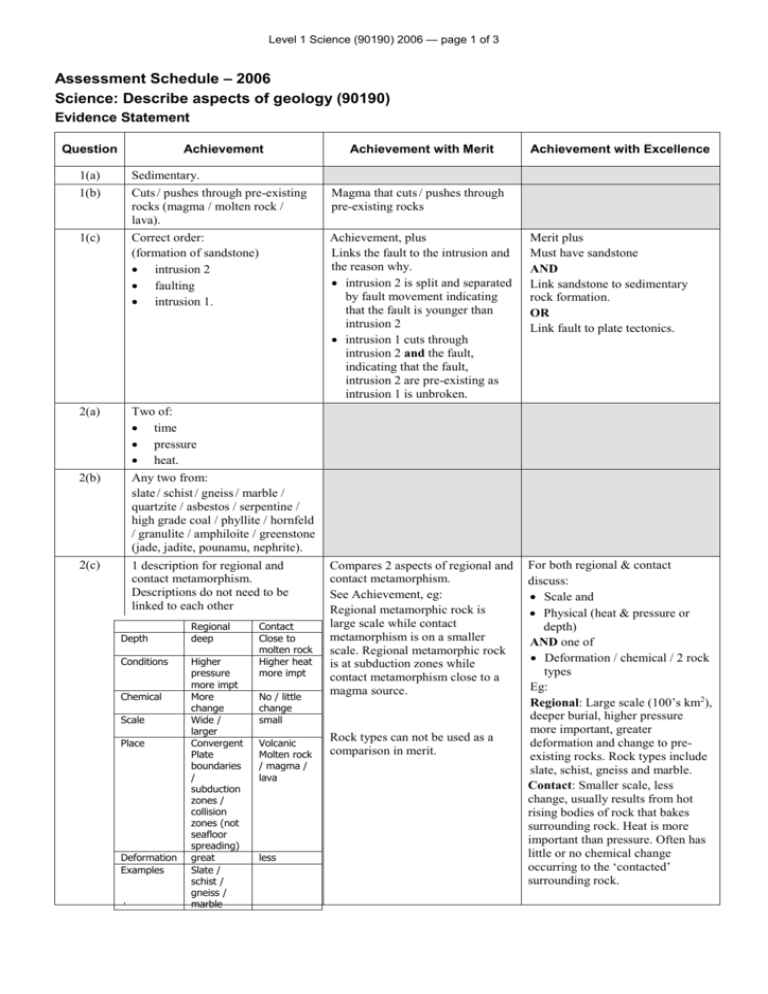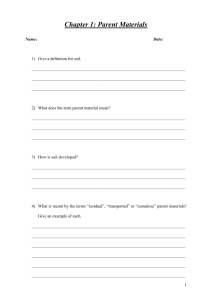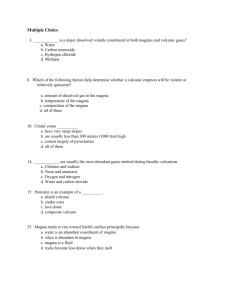85KB - NZQA
advertisement

Level 1 Science (90190) 2006 — page 1 of 3 Assessment Schedule – 2006 Science: Describe aspects of geology (90190) Evidence Statement Question Achievement 1(a) Sedimentary. 1(b) Cuts / pushes through pre-existing rocks (magma / molten rock / lava). Correct order: (formation of sandstone) intrusion 2 faulting intrusion 1. 1(c) 2(a) Two of: time pressure heat. 2(b) Any two from: slate / schist / gneiss / marble / quartzite / asbestos / serpentine / high grade coal / phyllite / hornfeld / granulite / amphiloite / greenstone (jade, jadite, pounamu, nephrite). 2(c) 1 description for regional and contact metamorphism. Descriptions do not need to be linked to each other Depth Conditions Chemical Scale Place Deformation Examples Regional deep Higher pressure more impt More change Wide / larger Convergent Plate boundaries / subduction zones / collision zones (not seafloor spreading) great Slate / schist / gneiss / marble Contact Close to molten rock Higher heat more impt No / little change small Volcanic Molten rock / magma / lava less Achievement with Merit Achievement with Excellence Magma that cuts / pushes through pre-existing rocks Achievement, plus Links the fault to the intrusion and the reason why. intrusion 2 is split and separated by fault movement indicating that the fault is younger than intrusion 2 intrusion 1 cuts through intrusion 2 and the fault, indicating that the fault, intrusion 2 are pre-existing as intrusion 1 is unbroken. Merit plus Must have sandstone AND Link sandstone to sedimentary rock formation. OR Link fault to plate tectonics. Compares 2 aspects of regional and contact metamorphism. See Achievement, eg: Regional metamorphic rock is large scale while contact metamorphism is on a smaller scale. Regional metamorphic rock is at subduction zones while contact metamorphism close to a magma source. For both regional & contact discuss: Scale and Physical (heat & pressure or depth) AND one of Deformation / chemical / 2 rock types Eg: Regional: Large scale (100’s km2), deeper burial, higher pressure more important, greater deformation and change to preexisting rocks. Rock types include slate, schist, gneiss and marble. Contact: Smaller scale, less change, usually results from hot rising bodies of rock that bakes surrounding rock. Heat is more important than pressure. Often has little or no chemical change occurring to the ‘contacted’ surrounding rock. Rock types can not be used as a comparison in merit. Level 1 Science (90190) 2006 — page 2 of 3 Question Achievement Achievement with Merit 2(d) Any two from: sandstone / mudstone (papa) / siltstone / limestone / coal / shale / chert / greywacke / argelite / breccia 2(e) Weathering / erosion / transport 2(f) Forms from a mixture of rock fragments / correct sedimentary process (deposition, cementation, compaction) but no link to fragment size. (describes the rock or the process) Basalt / scoria Mixture of rock fragments which are deposited, then cemented and compacted. (Lithification). 2(h) Recognises colour is linked to silica. Granite is rich / more in silica content, and gabbro is poor / less in silica. 2(i) States that granite forms underground / slow cooling and basalt at the surface / fast cooling. OR May state granite is plutonic and basalt is volcanic. OR Granite is intrusive and basalt is extrusive. OR Granite is formed from magma and basalt is formed from lava. OR Granite has large crystals / coarse grain and basalt has small crystals / fine grains. Relates two links of granite and basalt formation: 1. Place Volcanic / extrusive / above ground Plutonic / intrusive / underground 2. Cooling rate Granite slow cooling and basalt fast cooling. 3. Crystal size Granite has large crystals and basalt has small crystals. 3(a) A pile, stack, beds / layers or sequence of rock / relationship to age of the rock. All in correct order: E B C A D. 2(g) 3(b &c) Discusses the links between the different columns. There are two layers beneath C and two layers above C. Top, bottom and 2 middle layers relationship explained. Fossil content may be used as an index for correlation of layers / same fossils in any layer means layers are the same age. (diagram showing the clear correlations can be accepted). Achievement with Excellence Relates all 3 links: 1. Place 2. Cooling rate 3. Crystal size Magma and lava needs to be stated. Level 1 Science (90190) 2006 — page 3 of 3 Judgement Statement Science: Describe aspects of geology (90190) Achievement SEVEN questions answered correctly. Minimum of 7 A Achievement with Merit TEN questions answered correctly, including at least FOUR at Merit level. Minimum of 4 M + 6 A Achievement with Excellence ELEVEN questions answered correctly, including at least ONE at Excellence level and at least FOUR at Merit level. Minimum of 1 E + 4 M + 6 A






